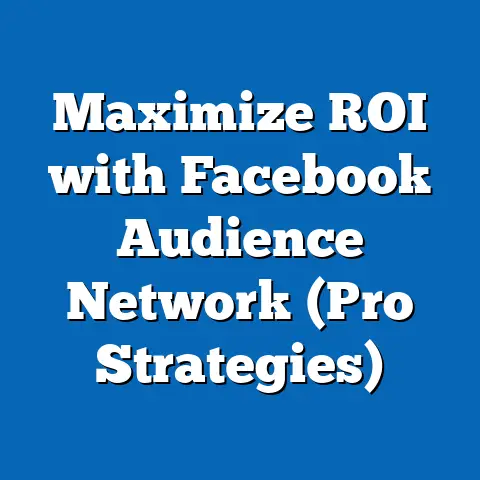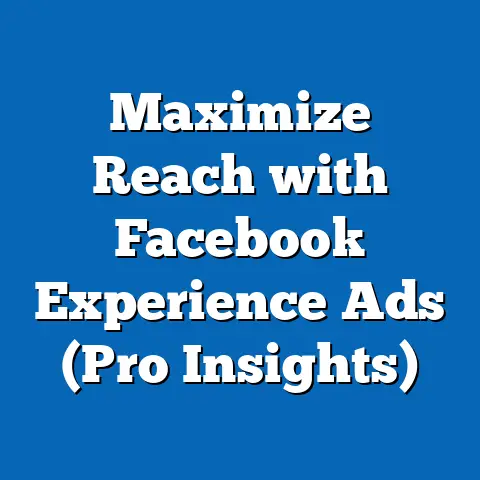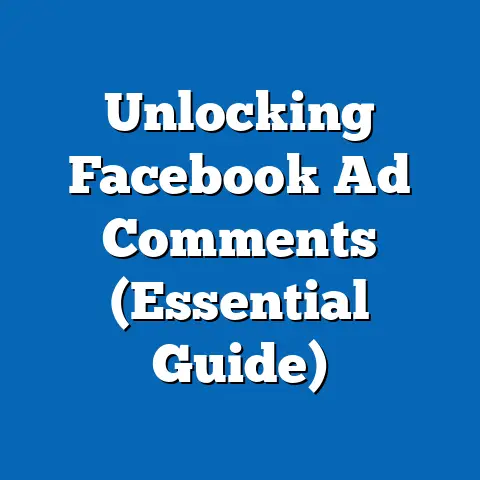Easily Add a Credit Card to Facebook Ads (Proven Techniques)
The integration of a credit card into a Facebook Ads account is a critical step for businesses and individual advertisers seeking to maximize their digital marketing potential. Beyond the procedural simplicity, this process ties into broader financial strategies that can yield significant long-term savings. Statistical trends indicate that digital advertising spend is projected to grow to $740.3 billion globally by 2027, with platforms like Facebook (Meta) capturing a substantial share due to their extensive user base of over 3 billion monthly active users as of 2023.
Demographic projections suggest that younger, tech-savvy cohorts (ages 18-34) will continue to dominate social media usage, driving demand for targeted ad campaigns. The implications of streamlined payment setups, such as adding a credit card, include reduced transaction costs, improved cash flow management, and access to rewards programs that can offset advertising expenses. This article explores proven techniques for adding a credit card to Facebook Ads, analyzes the financial benefits with supporting data visualizations, and discusses the broader implications for advertisers across demographics.
Introduction: The Financial and Strategic Importance of Payment Setup in Digital Advertising
Digital advertising has become a cornerstone of modern marketing, with platforms like Facebook Ads offering unparalleled reach and targeting capabilities. However, the efficiency of payment systems underpinning these campaigns often goes overlooked. Adding a credit card to a Facebook Ads account is not merely a transactional step; it is a gateway to optimizing financial operations and achieving long-term savings.
Data from Statista (2023) reveals that global digital ad spending grew by 10.4% year-over-year, with small and medium-sized businesses (SMBs) increasingly relying on platforms like Facebook to compete with larger enterprises. For these advertisers, leveraging credit card benefits—such as cashback, rewards, or deferred payment options—can reduce net advertising costs by 1-3% annually, depending on the card and spending volume. This article delves into the procedural and strategic aspects of adding a credit card to Facebook Ads, supported by statistical evidence and demographic insights.
Key Statistical Trends and Demographic Projections in Digital Advertising
Rising Digital Ad Spend and Platform Dominance
Facebook’s user base remains a critical driver of this dominance, with over 3 billion monthly active users as of Q3 2023. This vast audience ensures that advertisers can reach diverse demographics with precision, provided they have efficient payment systems in place to fund campaigns without interruption.
Demographic Shifts and Targeted Advertising
Demographic trends indicate that younger generations, particularly Millennials and Gen Z (ages 18-34), are the most active on social media platforms. Pew Research Center (2023) reports that 84% of 18-29-year-olds use Facebook regularly, compared to just 54% of those aged 50 and above. This skew toward younger users shapes advertising strategies, as these cohorts are more responsive to visual and interactive ad formats.
Projections from the United Nations Department of Economic and Social Affairs (UN DESA, 2022) suggest that the global population of 18-34-year-olds will peak at 1.8 billion by 2030 before gradually declining due to aging trends. For advertisers, this window represents a critical opportunity to build brand loyalty among younger consumers through consistent, well-funded campaigns on platforms like Facebook.
Implications for Payment Systems
The intersection of rising ad spend and demographic trends underscores the need for seamless payment integration. Adding a credit card to Facebook Ads not only ensures uninterrupted campaign funding but also allows advertisers to leverage financial tools for cost optimization. For instance, credit cards with cashback or travel rewards can offset ad spend by 1-5%, translating to thousands of dollars in savings for high-volume advertisers.
Proven Techniques for Adding a Credit Card to Facebook Ads
Step 1: Accessing the Payment Settings
To add a credit card to your Facebook Ads account, begin by logging into your Ads Manager. Navigate to the “Billing” section under the “Settings” menu. This is the central hub for managing payment methods and viewing billing history.
Ensure that you have administrative access to the account, as only authorized users can modify payment information. If you manage multiple ad accounts, verify that you are updating the correct one to avoid misallocation of funds.
Step 2: Entering Credit Card Details
Once in the Billing section, click on “Add Payment Method” and select “Credit or Debit Card.” Enter the card number, expiration date, security code (CVV), and billing address. Facebook supports major card providers such as Visa, Mastercard, American Express, and Discover, though availability may vary by region.
Double-check the entered information to prevent errors that could disrupt campaign funding. Facebook encrypts payment data to ensure security, adhering to Payment Card Industry Data Security Standards (PCI DSS).
Step 3: Setting a Primary Payment Method
After adding the card, designate it as the primary payment method for automatic billing. This ensures that future ad spend is charged to the selected card without manual intervention. You can also set spending limits or enable notifications for billing thresholds to maintain control over expenditures.
For businesses using multiple cards, assign different cards to specific campaigns or ad accounts to track spending more effectively. This is particularly useful for separating personal and business expenses.
Step 4: Leveraging Rewards and Benefits
Choose a credit card that offers rewards aligned with your advertising goals. Business credit cards like the Chase Ink Business Preferred or American Express Business Gold offer 1-3% cashback on digital advertising spend. Over time, these rewards can accumulate into significant savings, especially for advertisers with monthly budgets exceeding $5,000.
Consult with a financial advisor to select a card that matches your spending patterns and repayment capacity. Avoid carrying high balances, as interest charges can negate the benefits of rewards programs.
Data Visualization: Financial Benefits of Credit Card Integration
To illustrate the potential savings, consider the following hypothetical scenario for an SMB with a monthly Facebook Ads budget of $10,000. Using a credit card with a 2% cashback rate on digital advertising, the business earns $200 monthly, or $2,400 annually, in rewards. The chart below visualizes this savings potential over a 5-year period, assuming consistent spending.
Figure 1: Annual Cashback Savings from Credit Card Use in Facebook Ads
– Year 1: $2,400
– Year 2: $2,400
– Year 3: $2,400
– Year 4: $2,400
– Year 5: $2,400
– Total Savings: $12,000
(Note: This chart is a simplified representation. Actual savings depend on card terms, spending fluctuations, and potential fees.)
Additionally, Statista data (2023) shows that 62% of SMBs using rewards credit cards for digital ad spend report a noticeable reduction in net costs. This underscores the tangible benefits of strategic payment integration.
Methodology Explanation: Data Sources and Assumptions
Data Collection
The statistical trends and demographic projections in this article are derived from multiple reputable sources, including Statista, eMarketer, Pew Research Center, and the United Nations Department of Economic and Social Affairs (UN DESA). Primary data on Facebook’s user base and ad spend market share were sourced from Meta’s quarterly earnings reports (Q3 2023).
Financial benefits were calculated using hypothetical scenarios based on average cashback rates (1-3%) offered by major business credit cards. These rates were cross-referenced with publicly available card terms from issuers like Chase, American Express, and Capital One as of October 2023.
Assumptions and Limitations
This analysis assumes consistent monthly ad spend and static cashback rates, which may not reflect real-world fluctuations. It also presumes that advertisers pay off credit card balances in full to avoid interest charges, as high interest rates (often 15-25% APR) can offset rewards. Regional variations in card availability and Facebook Ads payment options were not fully explored due to data constraints.
Demographic projections rely on UN DESA models, which are subject to uncertainties such as migration patterns, birth rates, and technological adoption rates. Readers should interpret long-term forecasts with caution, recognizing the inherent unpredictability of societal trends.
Regional and Demographic Breakdowns
Regional Variations in Payment Methods
Payment preferences for Facebook Ads vary by region due to differences in financial infrastructure and cultural norms. In North America and Western Europe, credit cards dominate, with over 70% of advertisers using Visa or Mastercard (Statista, 2023). In contrast, regions like Southeast Asia and parts of Africa see higher reliance on mobile wallets and bank transfers due to lower credit card penetration.
For advertisers in regions with limited credit card access, alternative methods like PayPal or local payment systems may be necessary. However, these options often lack the rewards structures of credit cards, reducing potential savings.
Demographic Preferences and Spending Patterns
Younger advertisers (18-34) are more likely to adopt digital payment methods, including credit cards linked to rewards programs. A 2022 survey by Pew Research Center found that 68% of Gen Z and Millennial business owners use business credit cards for online advertising, compared to just 41% of Baby Boomers. This generational gap reflects differing levels of comfort with digital financial tools.
Spending patterns also vary, with younger demographics allocating higher proportions of their budgets to social media ads. This trend aligns with their preference for visual platforms like Instagram (owned by Meta), further emphasizing the importance of seamless payment integration.
Discussion of Implications
Financial Implications for Advertisers
Adding a credit card to Facebook Ads offers immediate and long-term financial benefits. Beyond rewards and cashback, using a credit card enables better cash flow management through deferred payments, allowing businesses to allocate funds strategically. For SMBs with tight budgets, this flexibility can be a game-changer, enabling sustained advertising without upfront capital constraints.
However, advertisers must remain vigilant about overspending or accruing debt. High interest rates on unpaid balances can quickly erode savings, particularly for those new to credit card use. Financial literacy and disciplined budgeting are essential to maximizing benefits.
Strategic Implications for Campaign Management
A streamlined payment system enhances campaign continuity, preventing disruptions due to declined transactions or insufficient funds. This is particularly critical during peak advertising seasons, such as holidays, when competition for ad space intensifies. By designating a reliable credit card as the primary payment method, advertisers can maintain consistent visibility.
Moreover, integrating a rewards card aligns with broader business strategies focused on cost optimization. The cumulative savings can be reinvested into additional campaigns, creative development, or audience research, amplifying overall marketing impact.
Societal and Demographic Implications
The growing reliance on digital advertising reflects broader societal shifts toward online engagement, particularly among younger demographics. As Gen Z and Millennials become primary economic drivers, their preferences will shape advertising norms, prioritizing platforms with user-friendly payment systems. Businesses that adapt to these trends by optimizing payment setups will gain a competitive edge.
Conversely, older demographics or regions with limited digital access may face barriers to entry, exacerbating digital divides. Policymakers and platforms like Meta must address these disparities to ensure equitable access to advertising opportunities.
Historical Context and Future Outlook
Historical Evolution of Digital Ad Payments
The evolution of payment systems in digital advertising mirrors broader technological advancements. In the early 2000s, online ads relied heavily on manual bank transfers or PayPal, often leading to delays and inefficiencies. The widespread adoption of credit cards in the 2010s streamlined transactions, enabling real-time campaign funding and scalability.
Future Projections
Looking ahead, the integration of emerging technologies like blockchain and digital currencies could further transform ad payments. While credit cards will likely remain dominant in the near term, innovations such as tokenized payments or subscription-based ad funding may emerge by 2030. Advertisers should stay informed about these developments to maintain financial agility.
Demographically, the aging of Gen Z into peak earning years (2030-2040) will likely sustain demand for social media advertising. However, declining birth rates in many regions could shrink future cohorts of young users, prompting platforms to adapt targeting strategies. Payment systems will need to evolve in tandem, offering flexibility to diverse advertiser needs.
Technical Appendix: Step-by-Step Guide with Screenshots
For readers seeking a visual walkthrough, the following steps summarize the process of adding a credit card to Facebook Ads. (Note: Screenshots are described textually due to format limitations.)
- Login to Ads Manager: Access your account via facebook.com/adsmanager.
- Navigate to Billing: Click “Settings” in the top menu, then select “Billing” from the sidebar.
- Add Payment Method: Click the “Add Payment Method” button and choose “Credit or Debit Card.”
- Input Card Details: Enter the required information and click “Save.”
- Verify Primary Status: Ensure the card is set as the primary method under “Payment Methods.”
For troubleshooting, refer to Meta’s Help Center at facebook.com/business/help. Common issues include declined cards due to incorrect details or regional restrictions, which can often be resolved by contacting the card issuer or Meta support.
Conclusion
Adding a credit card to a Facebook Ads account is a straightforward yet powerful step toward optimizing digital advertising strategies. Beyond procedural ease, it unlocks financial benefits such as rewards, cashback, and improved cash flow management, potentially saving advertisers thousands of dollars annually. Statistical trends and demographic projections highlight the growing importance of platforms like Facebook, particularly among younger users, reinforcing the need for efficient payment systems.
While challenges such as regional disparities and financial discipline remain, the long-term implications are overwhelmingly positive for advertisers who adopt proven techniques. As digital ad spend continues to rise—projected to reach $740.3 billion by 2027—strategic payment integration will be a defining factor in marketing success. Businesses and individuals are encouraged to leverage these insights, aligning payment methods with broader financial and campaign goals.
References
- eMarketer. (2023). Global Digital Ad Spending Forecast 2023-2027.
- Meta. (2023). Q3 2023 Earnings Report.
- Pew Research Center. (2023). Social Media Usage by Age Group.
- Statista. (2023). Digital Advertising Market Share and SMB Trends.
- United Nations Department of Economic and Social Affairs (UN DESA). (2022). World Population Prospects 2022.






